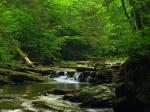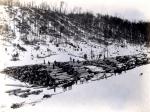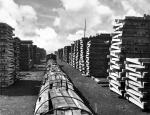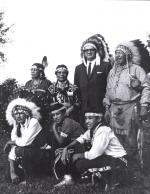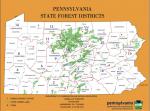Chapter One: Penn's Woods
When Europeans first explored the eastern shores of North America, trees covered more than 90 percent of Pennsylvania's 28,692,480 acres. Its moderate climate, abundant rainfall and rich soils gave rise to dense forests with plants and animals unknown in Europe.
Trees have always been Pennsylvania's most valuable renewable natural resource. The settlers who cut down the forests to clear the land for agriculture also viewed them as an obstacle. By 1850, millions of acres had been cleared for Pennsylvania's 128,000 farms. Pennsylvanians put their seemingly inexhaustible supply of trees to many uses. They used them to build their houses and fences, to cook their food and heat their homes. Pennsylvania was also rich with iron ore.
Between 1760 and 1895, more than four million acres of forest were harvested two to four times to feed the charcoal furnaces of Pennsylvania's iron industry. When the outbreak of the Civil War unleashed an unprecedented demand for the wood needed to build new railroads and fortifications, the nation turned to the forests of Pennsylvania, where "the trees came down like tall grass before a giant scythe."
In the decades before the Civil War, enterprising loggers headed to the white pine and hemlock forests of the Susquehanna. Each year they floated millions of logs down to the sawmills at towns like Lock Haven and
By the late 1800s, railroads were using more than 15 percent of the nation's timber supply. Each mile of track required 2,500 wooden railroad ties, which had to be constantly replaced. The coal mines, too, used billions of board feet of timber – more than the Pennsylvania forests could ever hope to provide – to prop up walls and ceilings. In the 1860s, a new pulpwood industry emerged, using trees unsuitable for lumber to make paper. Then came the wood chemical industry, which used the forests to produce alcohol, acetate, charcoal and tar.
Railroad logging, made possible by powerful geared locomotives, including those manufactured by the
By 1900, Pennsylvania had lost more than 60 percent of its forests. On the barren landscapes the loggers left behind, rains washed soil into the streams, and forest fires roared through the dead stumps, dry branches, scrub brush and saplings, devastating some 350,000 acres each year. Traveling through what the first state forest commissioner Joseph Rothrock called the "Pennsylvania Desert," a U.S. Geological surveyor reported "there are few places in the East where the natural beauties of mountain scenery and the natural resources of timber lands have been destroyed to the extent that has taken place in northern Pennsylvania."
As the loggers cut their way across the nation, small groups of Americans began to warn about the permanent loss of one of the nation's greatest natural resources. Fears of a "timber famine" gave birth to a national conservation movement for the protection and rejuvenation of forests for future use. In the 1870s, botanist
In the late nineteenth century, Americans had to go to Europe to learn the science of forestry. At Rothrock's prompting, the Pennsylvania legislature established the Mont Alto Forestry School in 1903, which under director
Forest recovery was a slow process. Trees had to be planted by hand, then protected from fires, deer and other threats. Even as the new state foresters were beginning to restore the state's woodlands, new menaces attacked the trees. In 1908 wealthy homeowners near Philadelphia noticed a blight that was killing their chestnut trees. In less than twenty years, chestnut blight would sweep across the state and wipe out a species that had once been the most common tree in the eastern forests. Gypsy moths arrived in 1920 and within a decade were eating mountainsides bare.
The fledging state forest system was still in bad condition when the Stock Market crashed in the fall of 1929. To jump-start the economy and re-employ men during the Great Depression, President Franklin Delano Roosevelt began a federal work-relief program unprecedented in American history. In 1933 he appointed Pennsylvania lawyer
In the middle decades of the twentieth century, growing numbers of Americans drove to the nation's forests to fish, hunt, hike and enjoy the beauties of nature. At the same time, the movement for the preservation of the nation's fast-disappearing wilderness areas was also gaining momentum and popular support. Pennsylvanians would play a major role in the wilderness preservation movement of the twentieth century.
By 2000, Pennsylvania had made great strides towards forest restoration. Close to 60 percent of the state was again covered in trees. A century after establishment of the Forestry Commission of Pennsylvania, the Commonwealth owned more than four million acres, 2.2 million of which were managed by the State Bureau of Forests. The $5-billion-a-year state forest products industry operated on a sustainable basis, growing more than two acres for every acre harvested, and employing more than 100,000 people. Pennsylvania's Allegheny National Forest was the largest federal forest east of the Mississippi, and sections of seventeen of Pennsylvania's rivers were forever preserved in their natural state. Once again, Americans came to Penn's woods to hunt, fish, camp, hike and enjoy the marvels of the natural world.
Penn's woods, however, continued to face old and new challenges. Forests and waters are extremely sensitive to the acidity of fresh water. For decades, automobiles and coal-fired power plants have released sulfur dioxide and other acidic gases into the atmosphere that rain then deposited on the ground. In the 1990s, Pennsylvania had the most acidic rain in the nation. These acids change soil chemistry, make it harder for plants to draw nutrients from the soil and weaken trees, causing widespread forest damage. Acid rain also weakens trees' resistance to natural predators.
Invasive plants and insects are some of the most dangerous threats to Pennsylvania ecosystems. Sections of the state have been overrun by Norway maple, Japanese knotwood, autumn olive and other plants imported from abroad. Purple loosestrife, for example, a popular plant with home gardeners, escaped into the wild and rapidly displaced native plants, choked wetlands and caused millions of dollars of economic damage. Dogwood anthracnose fungus had killed close to 80 percent of eastern dogwoods by the year 2000. The wooly adelgid, a parasitic insect from Asia, has killed hemlocks from Massachusetts to North Carolina. The Asian long-horned beetle, which entered the country in wooden pallets from China, threatens to cause tens of billions of dollars in damage by attacking a wide range of American trees.
In the twentieth century, white-tailed deer emerged as one of the greatest threats to Penn's woods. The clear-cutting of the state's forests between the 1870s and 1920s created the perfect habitat for white-tailed deer, which fed on the ground plants and seedlings that took root in the sunlight. With their natural predators eliminated and hunting restricted by the state, Pennsylvania's deer population exploded and devastated the state's forests.
Reaching historically unprecedented concentrations of more than sixty per square mile - game experts believe that they averaged less than ten per square mile when Europeans first arrived in North America - deer now dictate the composition of natural ecosystems. Eating the native species of shrubs, wild flowers, grasses and other low-lying plants, they bared forest floors that were then invaded by New York fern, hay-scented fern and other native species that they do not like to eat, and by stiltgrass, garlic mustard, autumn olive, Amur honeysuckle and other non-native invaders from abroad. By eating and killing off the seedlings and saplings that regenerate woodlands they have radically altered the state's forests.
At the dawn of the twenty-first century, Penn's woods remained under assault as overgrazing by deer, acid rain and other airborne pollutants, invasive plants and insects, fire suppression and other forces continued to bring radical environmental changes.








